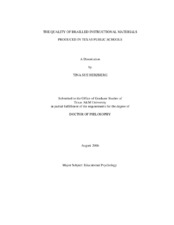| dc.description.abstract | This study investigated the quality of braille transcription in public schools in
Texas. In the first phase, an electronic survey of 94 school personnel across the state
found that instructional materials are often transcribed by a variety of personnel not
certified by the Library of Congress. In addition, the majority of survey respondents felt
that their initial training had not adequately prepared them. Not surprisingly, transcribers
and braillists reported that they spent more time each week transcribing materials than
did teachers of the visually impaired.
In the second phase, 40 transcriptions prepared by school personnel were
examined. The quality of the transcriptions varied greatly. More than 30% (n=13) of the
transcriptions contained four or less errors. The other transcriptions (n=27) contained a
variety of contraction errors, misspelled words, misformed characters, omission of letters
or words, insertion of additional letters, detectable erasures, and formatting errors.
Perception of quality by the person transcribing often did not reflect the actual quality of
the transcription. The data in this study indicated that neither years of experience nor
certification status have a decisive effect on quality. On the other hand, the salient
characteristic in predicting the quality of braille produced by the participants was time spent each week transcribing materials, which, in turn, was associated with the job role
of the participant.
In the third phase, members of a focus group assessed a representative subset of
the transcriptions. The findings of the focus group revealed that errors would prevent
legibility for some students, and that errors in transcribing negatively affect the academic
performance of braille readers. The data in all three phases supported the need for
developing a formal definition of quality in braille transcribing and providing ongoing,
standardized training for school personnel. Perhaps most importantly, the data gained
from this study supported the hypothesis that braille readers receive instructional
materials that are not equal in quality to those received by other students. | en |


